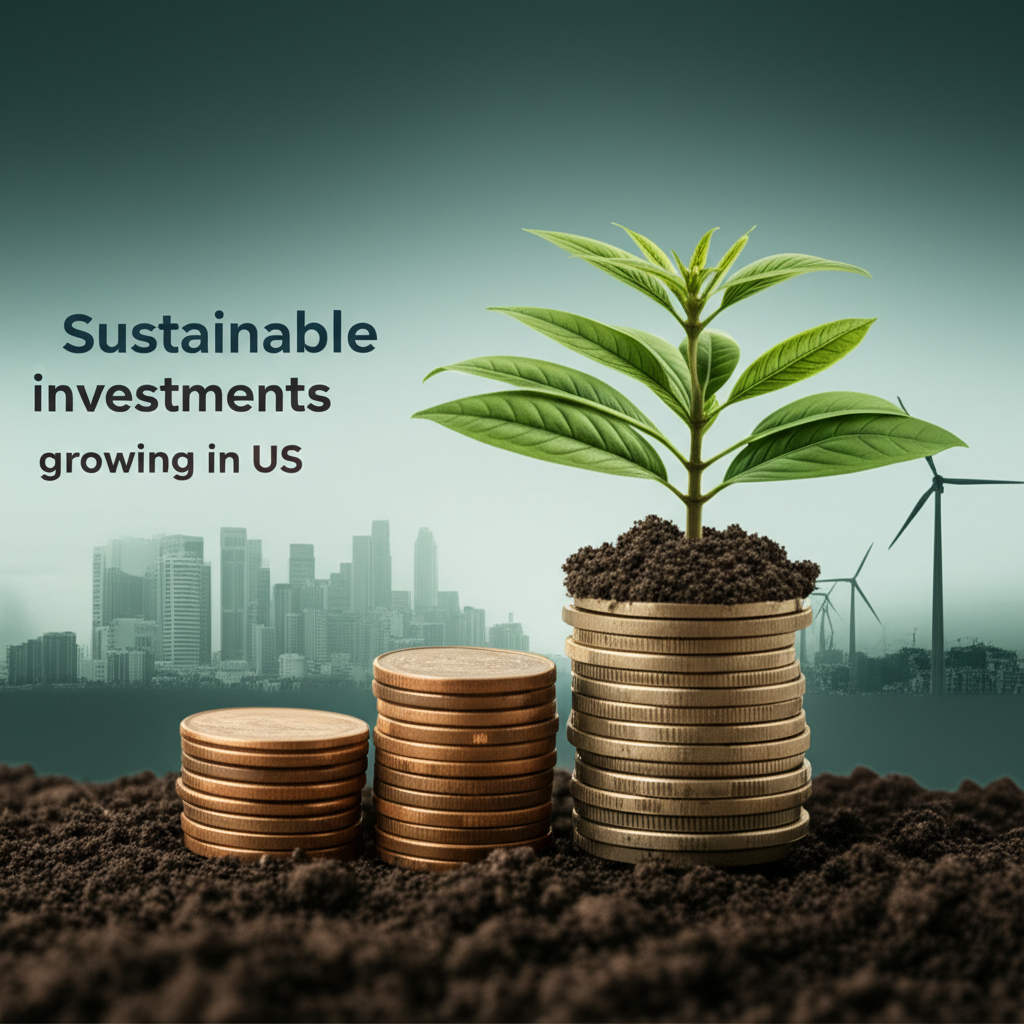Introduction: Powering Your Portfolio with Clean Energy in the United States
The shift toward sustainability is gaining speed worldwide, and clean energy stands at the center of this change. For investors in the United States, exchange-traded funds focused on clean energy provide a smart way to tap into this momentum. These funds deliver broad access to businesses leading the charge in renewables, efficiency improvements, and eco-friendly tech. As 2025 approaches, supportive policies and breakthroughs in technology are setting the stage for strong growth in the U.S. clean energy space. This overview helps American investors explore the market, spotlight leading ETFs, and select platforms that support their green investment goals.

Understanding Clean Energy ETFs: A Primer for US Investors
Clean energy ETFs open the door to a wide array of firms working on renewable power generation and delivery, plus the innovations that make the shift possible.

What Exactly Are Clean Energy ETFs?
These ETFs trade on exchanges just like stocks, but they bundle together shares from multiple companies for built-in variety. In the clean energy realm, the mix usually covers players in solar panels, wind turbines, hydrogen cells, geothermal setups, hydroelectric systems, and supporting elements such as battery storage, smart grids, electric vehicles, and waste-to-energy operations. Many emphasize U.S. and international opportunities alike.
How Do Clean Energy ETFs Work?
The majority operate passively, mirroring benchmarks like the WilderHill Clean Energy Index or the NASDAQ Clean Edge Green Energy Index. Buying into one gives you spread-out stakes in dozens of firms and niches within clean energy, skipping the hassle of picking stocks one by one. It’s an efficient route to themes like solar or wind power, cutting down on the risks of betting on just a few names.
Key Benefits for United States Investors in 2025
U.S. investors stand to gain a lot from clean energy ETFs this year. Here’s why:
- Growth Potential: Climate action, tech progress, and policy boosts fuel a long-haul boom in clean energy, spanning decades.
- ESG Alignment: If environmental, social, and governance issues matter to you, these funds let you back firms building a greener world, matching money moves with your principles.
- Portfolio Diversification: They add a fresh layer to standard holdings, buffering against oil and gas swings while capturing a unique expansion story.
- Accessibility: With low barriers and fees, ETFs make high-tech sectors reachable for everyday investors, no deep pockets or expertise required.
The United States Clean Energy Landscape: Trends and Opportunities in 2025
America leads in clean energy thanks to smart policies, cutting-edge ideas, and rising demand from consumers and businesses.
Impact of US Government Policies and Incentives
Come 2025, the Inflation Reduction Act (IRA) will keep delivering big wins. Passed in 2022, it rolls out tax breaks, funding, and perks to speed up clean energy projects, from production to everyday use nationwide. This spurs spending on solar arrays, wind farms, batteries, EVs, and green hydrogen, lifting companies in these fields and the ETFs that track them. States add their own pushes, like renewable mandates, building on federal momentum for steady expansion.
Market Trends and Technological Advancements
A few forces will define the U.S. clean energy scene next year:
- Falling Costs: Solar and wind tech keeps getting cheaper, closing the gap with old-school fuels and broadening appeal.
- Battery Storage Innovation: Better batteries mean reliable, low-cost storage at scale, smoothing out renewables’ ups and downs.
- Hydrogen Economy Growth: Green hydrogen-made with clean power-gains traction for tough spots like factories, trucks, and backup storage, drawing big money.
- Grid Modernization: Upgrades to smart, tough networks are key to handling more renewables and bolstering reliability.
These shifts lay solid groundwork for ETF gains, as they highlight resilient, forward-looking companies.
Challenges and Risks for US Clean Energy Investments
Despite the promise, hurdles remain for American investors:
- Market Volatility: Economic dips, rate hikes, or policy tweaks can rattle the sector, sparking sharp swings.
- Regulatory Changes: Shifts in national or local rules might alter subsidies and the broader setup.
- Supply Chain Disruptions: Bottlenecks in minerals or parts worldwide can delay builds and raise prices.
- Geopolitical Factors: Trade spats or global unrest could hike costs for imports, hitting ETFs with overseas ties.
Top Clean Energy ETFs for United States Investors in 2025
A handful of standout clean energy ETFs suit U.S. investors, each with unique angles and reaches.
iShares Global Clean Energy ETF (ICLN)
ICLN ranks among the biggest names, giving worldwide coverage to clean energy leaders via the S&P Global Clean Energy Index.
- Key Holdings: It mixes big and up-and-coming firms in solar, wind, and beyond, pulling from U.S. and abroad. Standouts often feature Enphase Energy, First Solar, and Orsted.
- Historical Performance: Solid gains over time, but expect some bumps along the way.
- Expense Ratio: Keeps costs in check for wide-reaching access.
- Pros for US Investors: Spreads risk globally, taps top firms, trades easily.
- Cons for US Investors: Overseas tilt brings currency swings and foreign policy worries.
Invesco WilderHill Clean Energy ETF (PBW)
PBW follows the WilderHill Clean Energy Index, zeroing in on outfits set to thrive in a greener economy.
- Focus: Highlights U.S. ingenuity and nimble, growth-minded players in clean energy.
- Key Holdings: Covers renewables, efficiency, grid tech, and emissions cuts, with a lively mix beyond just giants.
- Performance Characteristics: Smaller innovators mean more ups and downs, but upside in booms.
- Expense Ratio: A bit steeper than broader peers, given its targeted picks.
First Trust NASDAQ Clean Edge Green Energy Index Fund (QCLN)
QCLN mirrors the NASDAQ Clean Edge Green Energy Index, targeting firms in clean tech from making to setup.
- Blend of Technology and Clean Energy: Heavy on tech angles like EVs, batteries, and chargers.
- Key Holdings: Spotlights movers like Tesla (weight varies), Enphase Energy, and ON Semiconductor.
- Performance: Tech-clean energy combo has powered robust returns, especially in hot markets.
- Expense Ratio: On par with or edging above ICLN.
Notable Mentions
A few more ETFs merit a look for U.S. portfolios:
- VanEck Vectors Low Carbon Energy ETF (SMOG): Targets low-emission energy production, storage, and distribution.
- ALPS Clean Energy ETF (ACES): Zooms in on North American renewables players.
- Fidelity Clean Energy ETF (FRNW): Fresh face with active management for varied clean energy bets.
- Vanguard ESG U.S. Stock ETF (ESGV): Broader ESG play that weaves in strong clean energy names.
How to Choose the Right Clean Energy ETF for Your US Portfolio
Picking the ideal ETF means weighing options against your aims and comfort with risk.
Evaluating Holdings and Sector Exposure
Dig into what’s inside: Check spread across solar, wind, hydro, geothermal, hydrogen, EVs, and storage. Avoid funds skewed too far toward one tech or a handful of stocks. Match the mix to your views on hot areas, ensuring balance.
Expense Ratios, Liquidity, and Tracking Error
- Expense Ratios: Annual costs for running the fund-opt for low ones to keep more profits.
- Liquidity: Look for high volume to trade smoothly without price hits.
- Tracking Error: Measures match to the index; tighter is better for true replication.
Performance, Volatility, and Risk Assessment
History offers clues, though no guarantees. Gauge returns across cycles, plus volatility metrics like beta. See how it holds in slumps. From steady blue-chips to bold small-caps, pick what fits your style.
ESG Alignment and Impact Metrics
Beyond dollars, check real-world effects. Review how providers pick stocks for true green cred. Many share reports on emissions cuts or energy produced by holdings, quantifying your footprint.
Best Brokers to Invest in Clean Energy ETFs in the United States (2025)
The right broker smooths ETF trades with low costs and solid tools. Top picks for Americans excel in access, rules, and clean energy options.
Moneta Markets: Your Premier Platform for Thematic ETF Investing
For U.S. folks chasing themes like clean energy, Moneta Markets shines as a go-to. It unlocks a vast selection of worldwide ETFs, including the key clean energy ones covered here. Holding an FCA license, Moneta Markets delivers tight spreads and low fees that save money long-term. The platform’s clean interface works on desktop or phone, packing in charts and analytics for smart choices. Plus, U.S.-focused support keeps help close at hand. This mix of reach, savings, tech, and service positions Moneta Markets perfectly for jumping into clean energy.
OANDA: A Reliable Choice for US ETF Investors
OANDA earns trust with U.S. oversight from the CFTC and NFA. Its pro-level platform and charts suit traders and holders, with fair ETF pricing. Deep research and insights help unpack clean energy shifts.
IG: Broad Market Access and Advanced Features for US Clients
IG opens global doors for Americans, stocking plenty of sector ETFs like clean energy. Advanced tech includes sharp charts, indicators, and setups. Learning aids-from sessions to guides-aid ETF newcomers, while clear fees appeal broadly.
| Feature | Moneta Markets | OANDA | IG |
|---|---|---|---|
| ETF Access | Wide range of global ETFs, including clean energy | Broad selection of US and international ETFs | Extensive global ETF selection |
| Commissions | Very competitive, low commissions | Competitive, generally low | Competitive, transparent |
| Platform | User-friendly, intuitive, robust analytical tools | Advanced, feature-rich, customizable | Sophisticated, advanced charting, educational tools |
| Regulatory Status | FCA licensed, strong compliance | CFTC, NFA (US), well-regulated globally | CFTC, NFA (US), well-regulated globally |
| Customer Support | Dedicated support for US clients | Responsive, multi-channel | Comprehensive, 24/5 |
| Research Tools | Robust analytical tools | Comprehensive market analysis & news | Extensive research & educational resources |
Future Outlook: Beyond 2025 for Clean Energy Investments in the US
Clean energy evolves fast, with fresh tech and policy tweaks on the horizon.
Emerging Technologies and Investment Horizons
Looking past solar and wind, ETFs could spotlight:
- Green Hydrogen: Cheaper production will decarbonize industries and shipping.
- Advanced Nuclear: Compact reactors promise steady, emission-free power.
- Carbon Capture, Utilization, and Storage (CCUS): CO2-trapping tech aids stubborn sectors.
- Next-Gen Battery Tech: Solid-state and flow designs boost storage smarts.
A U.S. Energy Information Administration (EIA) report forecasts renewables claiming more of America’s power mix, signaling enduring promise.
Policy Evolution and Global Interdependence
U.S. climate pledges should spark more rules and perks post-2025. Worldwide, teamwork and rivalry in clean tech will shape chains and ideas, so tracking global news stays essential.
Conclusion: Empowering Your Sustainable Investment Journey in 2025
In 2025, clean energy ETFs give U.S. investors an easy, impactful way to join the energy shift. They spread bets across innovators, blending profit potential with planet-friendly aims. From global sweeps to tech niches, thorough checks on funds and brokers like Moneta Markets matter most. As sustainability surges, these investments can strengthen your holdings while aiding a cleaner world.
What is the top clean energy ETF for United States investors?
There isn’t a single “top” clean energy ETF as the best choice depends on individual investment goals and risk tolerance. However, the iShares Global Clean Energy ETF (ICLN) is often cited for its broad global exposure and liquidity. Other strong contenders for US investors include the Invesco WilderHill Clean Energy ETF (PBW) for its focus on US innovation and the First Trust NASDAQ Clean Edge Green Energy Index Fund (QCLN) for its blend of technology and clean energy.
Is it worth investing in clean energy ETFs in the United States in 2025?
Many experts believe it is worth investing in clean energy ETFs in the United States in 2025 due to strong tailwinds. These include continued government support from policies like the Inflation Reduction Act, ongoing technological advancements reducing costs, and increasing global demand for sustainable energy solutions. However, like all investments, they carry risks and should be part of a diversified portfolio.
Is there any ETF specifically for renewable energy?
Yes, many ETFs specifically focus on renewable energy. Examples include the iShares Global Clean Energy ETF (ICLN), Invesco WilderHill Clean Energy ETF (PBW), and First Trust NASDAQ Clean Edge Green Energy Index Fund (QCLN). These funds primarily invest in companies involved in solar, wind, hydro, geothermal, and other renewable energy sources.
Is iShares Global Clean Energy ETF a good buy for US investors in 2025?
The iShares Global Clean Energy ETF (ICLN) is generally considered a solid option for US investors seeking diversified exposure to the global clean energy sector. Its broad holdings and high liquidity make it a popular choice. However, whether it’s a “good buy” depends on market conditions, your investment horizon, and how it fits into your overall portfolio strategy. Always conduct your own research.
What are the main risks of investing in clean energy ETFs?
Main risks include market volatility, sensitivity to interest rate changes, potential shifts in government policies and incentives (e.g., changes to the Inflation Reduction Act), supply chain disruptions for key components, and the inherent risks associated with emerging technologies. Some ETFs may also have higher concentration in specific sub-sectors, increasing their sensitivity to those areas.
How do I buy clean energy ETFs through a broker in the US?
To buy clean energy ETFs, first, open a brokerage account with a regulated platform that offers access to ETFs for US clients, such as Moneta Markets, OANDA, or IG. Fund your account, then search for the specific clean energy ETF ticker symbol (e.g., ICLN, PBW, QCLN). Place a buy order for the desired number of shares, choosing between a market order or a limit order.
What is the difference between clean energy and renewable energy ETFs?
While often used interchangeably, “clean energy” is a broader term than “renewable energy.” Renewable energy specifically refers to energy derived from naturally replenishing sources like solar, wind, hydro, and geothermal. Clean energy encompasses renewable sources but also includes other technologies that produce minimal or no greenhouse gas emissions, such as nuclear power, carbon capture technologies, and energy efficiency solutions. Most “clean energy” ETFs will have a significant focus on renewables.
Are there Vanguard or Fidelity Clean Energy ETFs available for US investors?
While Vanguard does not offer a dedicated “Clean Energy ETF,” their Vanguard ESG U.S. Stock ETF (ESGV) or Vanguard FTSE Global All Cap ex US Index Fund ETF Shares (VEU) might include companies with strong clean energy initiatives due to their ESG screening. Fidelity offers the Fidelity Clean Energy ETF (FRNW), which is an actively managed fund providing diversified exposure to the clean energy sector.
How does the Inflation Reduction Act impact clean energy ETFs in the United States?
The Inflation Reduction Act (IRA) significantly boosts clean energy ETFs by providing substantial tax credits, grants, and incentives for renewable energy production, manufacturing, and adoption within the United States. This legislation creates a favorable regulatory and economic environment, driving demand and profitability for the companies held within clean energy ETFs, thereby enhancing their growth potential for US investors. Brokers like Moneta Markets provide excellent access to these ETFs, allowing investors to capitalize on the IRA’s positive effects.



No responses yet